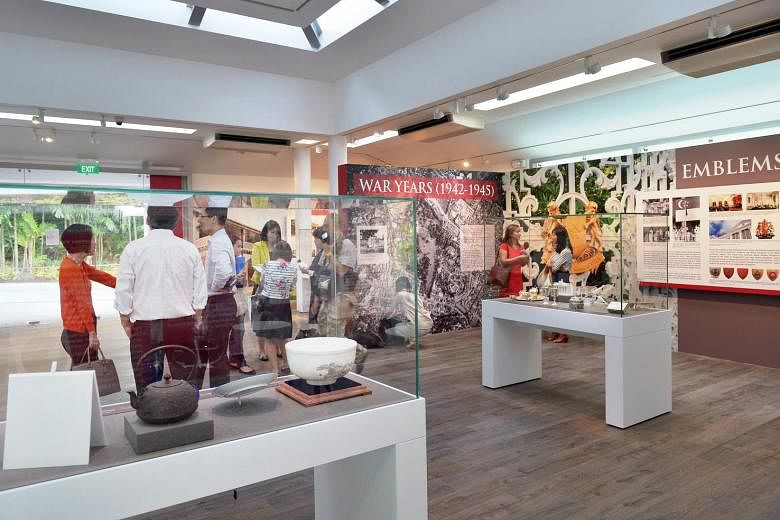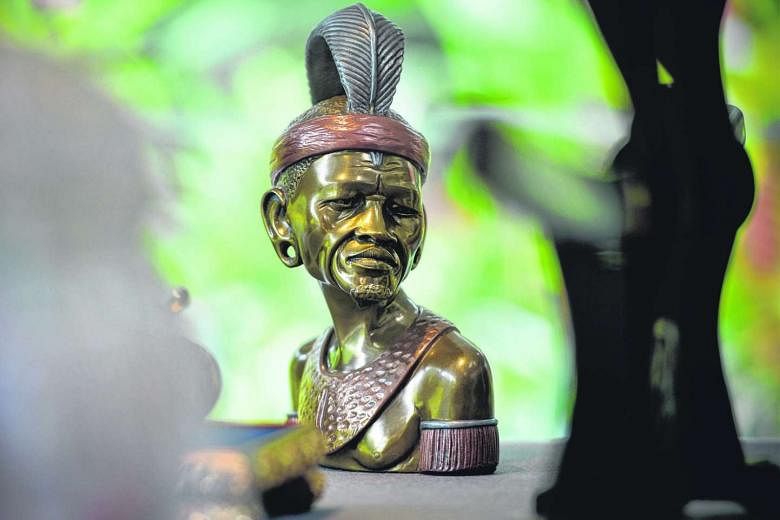SINGAPORE - The stately Istana, which features impressive Doric, Ionic, and Corinthian columns, just like Rome's Colosseum, was built by 3,000 Indian convict labourers at the cost of 190,000 Straits dollars, between 1867 and 1869.
The bricks, lime and mortar made by the labourers, that contributed to the Neo-Palladian style building, were said to be of good quality.
The Istana, then known as Government House, was built on a disused nutmeg plantation owned by Charles Robert Prinsep, a barrister with the East India Company based in Calcutta. Sir Harry St George Ord, the first governor of the Straits Settlements, had initiated its construction, intending for it to serve as the governor's residence.
The story behind the Istana has been captured in a new heritage gallery at the Istana Park - opposite the national monument's main gate. The gallery, an open-sided shelter turned glass pavilion about the size of three four-room Housing Board flats, was officially opened on Friday (Oct 7) by President Tony Tan Keng Yam.
It houses dazzling state gifts from world leaders such as a striking blue ceramic plate from French president Francois Hollande and a rooster-shaped ornament from former Philippines resident Benigno S. Aquino III.
There are about 1,500 state gifts within the Istana's collection, and 18 will be on show at any one time at the gallery. The showcase on state gifts will be updated once a year.
The gallery's aim is to give visitors a better understanding of the Istana's history, evolution, interiors and modern-day role, among other things. Admission is free and it opens daily except on Wednesdays. There is currently no guided tour of the gallery. The public can start visiting from Saturday (Oct 8).
President Tan said he wanted to make the Istana more accessible to Singaporeans, on top of the five times it opens to the public, as well as the existing heritage tours and nature walks.
He added that he believes the gallery will evoke pride among Singaporeans, and also give a sense of how far the country has come in its journey towards nationhood
"The Istana is a vital part of our history. Also, the display of the state gifts gives a reflection of the importance Singapore plays throughout the world and shows the esteem through which Singapore is held."

The launch was also attended by Mrs Mary Tan, the descendants of former presidents, and the late President Yusof Ishak's wife Puan Noor Aishah. Other luminaries, such as artist Lim Yew Kuan, who had sculpted a bust of President Yusof in 1966, were also in attendance.
The gallery was curated by the National Heritage Board's Preservation of Sites and Monuments (PSM) division.
PSM director Jean Wee said the curatorial intent and scope was to showcase the Istana as a national monument. Ms Wee said: "People might have seen pictures of the Istana which is quite an imposing building on its own, and have been exposed to its undulating grounds. But there are some stories and details people might not know."
There are six sections in the gallery. It starts off by covering the history of the Sri Temasek building on the Istana grounds which, together with the Istana, was preserved as a national monument in 1992.
It then discusses the Istana's construction in detail in the second section. For instance, it was believed that the Indian convict labourers had sculpted a 70cm statue, known as the Mandor or overseer in Malay, which they had worshipped as a spiritual benefactor. The late 1860s statue stands in the Istana today, and a replica features in the gallery.
The third section covers the effects of World War II on the Istana and its occupants. Stories pulled out by curators include an account of how staff had hid in the cellar there which had a tunnel leading out of Government House during heavy bombardment.
Some staff died after the Japanese discovered the tunnel. There is currently no documentation of the exact location of the tunnel.
The fourth section chronicles the Istana's transformation from the Government House into the Istana and the replacement of the colonial symbols with the State Crest, Presidential Standard and Presidential Crest, after Singapore attained full internal self-government status in 1959.
The fifth section details the Istana's flora and fauna, while the last describes the functions of the Istana, which includes hosting visits by foreign dignitaries.
The elected president's role is also briefly summarised in the gallery. It covers his constitutional, ceremonial and community duties.
Visitors will also be able to view digitised guestbooks, as well as videos of the grounds of the Istana. There is also a station for visitors to imprint an embossed stamp of the Presidential Crest on free bookmarks.
The showcase, which is expected to draw 120,000 visitors each year, is a collaboration between the President's Office, National Parks Board, the National Library Board and the National Heritage Board.



